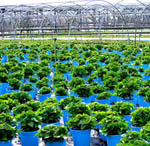Reducing the negative ecological impacts from biofuel production
 Agriculture,
Agriculture,  Energy,
Energy,  Plants
Plants  Giant reed (Arundo donax), a highly invasive plant in many parts of the world, has been promoted as a biofuel crop. Image credit, Kim Starr, USGS.In the search for alternatives to petroleum-based energy sources, some people tout biofuels as an earth-friendly solution. Often overlooked, however, are ecological impacts of large-scale cultivation of biofuel crops.
Giant reed (Arundo donax), a highly invasive plant in many parts of the world, has been promoted as a biofuel crop. Image credit, Kim Starr, USGS.In the search for alternatives to petroleum-based energy sources, some people tout biofuels as an earth-friendly solution. Often overlooked, however, are ecological impacts of large-scale cultivation of biofuel crops.
Two new articles in the journal Frontiers in Ecology and the Environment show that dramatic expansion of biofuel agriculture may reduce biodiversity and promote the spread of invasive species. The articles also make a number of recommendations for reducing the ecological impact from biofuel production.
Impacts on biodiversity?
Biofuel production in the United States relies on four major crops: corn, switchgrass, pine, and poplar. A rapid rise in biofuel production is driving a huge increase in acreage dedicated to growing biofuel crops. Corn acreage, for example, jumped 19% from 2006 to 2007.
Robert Fletcher and several colleagues conducted a meta-analysis to examine impacts of biofuel agriculture on vertebrate biodiversity in the United States. Analyzing data from 15 studies that compared biodiversity in biofuel croplands to natural habitats or low-intensity land use, they concluded that,
“Land-use change from non-production habitats into land dedicated to major biofuels crops may have negative impacts on biodiversity in the U.S.”
Compared to other biofuel crops, corn appears to be the worst offender, and the authors suggest that replacing cornfields with poplar or pine plantations “may have net biodiversity benefits.” The authors also recommend reducing the use of agricultural chemicals, delaying harvests until after bird-breeding season, and increasing heterogeneity in crop plantings to minimize the loss of biodiversity due to biofuel production.
Invasion of the biofuel crops?
Plant species desirable as biofuel crops tend to be fast growing, large, efficient in their use of nutrients and water, and capable of thriving in a wide variety of environments. These traits are also characteristic of weedy, invasive species.
As the production of biofuels increases, weed-like species are being planted in large numbers across swaths of the United States. So far, little attention has been given to the possibility for these plants to invade the landscape outside farms and to degrade ecosystem functions.
In a new research article, Adam Davis and his collaborators conclude that biofuel crops have considerable potential to become invasive, causing severe ecological harm. For example, giant reed (Arundo donax), a highly invasive plant in North America and many other parts of the world is being actively promoted as a biofuel feedstock species in the Gulf Coast states where plantations covering thousands of acres have been proposed.
The researchers recommend developing an ecological risk assessment framework for biofuel species and carefully screening before individual species are widely planted.
They conclude that, “Greater collaboration between agronomists developing crops for biofeedstock production and invasion biologists could substantially lower the risk of new plant invasions.”
Looking ahead...
This pair of research articles indicates that rising production of biofuel crops could have unintended consequence for native plants and animals. However, careful consideration of the species to be cultivated and the agricultural practices to be used may reduce negative ecological impacts of producing biofuels.
--Reviewed by Peter Taylor
Davis, A., Cousens, R., Hill, J., Mack, R., Simberloff, D., & Raghu, S. (2010). Screening bioenergy feedstock crops to mitigate invasion risk Frontiers in Ecology and the Environment DOI: 10.1890/090030
Fletcher, R., Robertson, B., Evans, J., Doran, P., Alavalapati, J., & Schemske, D. (2010). Biodiversity conservation in the era of biofuels: risks and opportunities Frontiers in Ecology and the Environment DOI: 10.1890/090091




Reader Comments